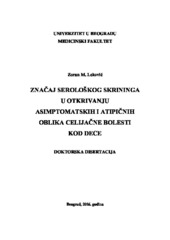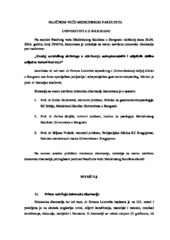Приказ основних података о дисертацији
Značaj serološkog skrininga u otkrivanju asimptomatskih i atipičnih oblika celijačne bolesti kod dece
Importance of serological screening in detection of asymptomatic and atypical forms of celiac disease in children
| dc.contributor.advisor | Radlović, Nedeljko | |
| dc.contributor.other | Đuranović, Srđan | |
| dc.contributor.other | Stojšić, Zorica | |
| dc.contributor.other | Vuletić, Biljana | |
| dc.creator | Leković, Zoran M. | |
| dc.date.accessioned | 2016-09-03T19:11:05Z | |
| dc.date.available | 2016-09-03T19:11:05Z | |
| dc.date.available | 2020-07-03T08:46:51Z | |
| dc.date.issued | 2016-07-12 | |
| dc.identifier.uri | https://nardus.mpn.gov.rs/handle/123456789/6410 | |
| dc.identifier.uri | http://eteze.bg.ac.rs/application/showtheses?thesesId=3734 | |
| dc.identifier.uri | https://fedorabg.bg.ac.rs/fedora/get/o:12567/bdef:Content/download | |
| dc.identifier.uri | https://fedorabg.bg.ac.rs/fedora/get/o:12724/bdef:Izvestaj/download | |
| dc.identifier.uri | http://vbs.rs/scripts/cobiss?command=DISPLAY&base=70036&RID=48102671 | |
| dc.description.abstract | Celijaĉna bolest je autoimunsko oboljenja koje nastaje kao posledica poligenske predispozicije i izloţenosti glutenu. Imajući u vidu da genetski faktor igra veoma znaĉajnu ulogu u nastanku celijaĉne bolesti, poremećaj karakteriše visoka uĉestalost meĊu bliskim srodnicima obolelog, naroĉito onih prvog reda. TakoĊe, celijaĉnu bolest karakteriše i visoka udruţenost (3-10%) sa ostalim autoimunim oboljenjima kao što su dijabetes melitus tip I, autoimuni tireoiditis, juvenilni idiopatski artritis i druga. Visoka uĉestalost celijaĉne bolesti se sreće i u selektivnim deficitu IgA, kao i Down, Turner i Williams sindromu. Osnovu dijagnoze bolesti ĉini enterobiopsija sa patohistološkim pregledom sluzokoţe tankog creva. Zahvaljujući visokoj senzitivnosti i specifiĉnosti IgA antitela na tkivnu transglutaminazu (>95%), ĉiji nivo korelira sa stepenom oštećenja sluzokoţe tankog creva, kao i ĉinjenici da se kod ovih bolesnika gotovo redovno verifikuje prisustvo HLA DQ2 i/ili DQ8 (>98%), najnovije preporuke Evropskog udruţenja za deĉju gastroenterologiju, hepatologiju i nutriciju (European Society for Pediatric Gastroenterology, Hepatology, and Nutrition, ESPGHAN), definisane 2010. godine, ukazuju da ova procedura nije neophodna kod bolesnika sa simptomima i/ili znacima koji odgovaraju celijaĉnoj bolesti, a uz to poseduju titar IgA antitela na tkivnu transglutaminazu deset puta iznad gornje granice normalne vrednosti, pozitivna antiendomizijumska antitela i HLA DQ2 i/ili DQ8. Dodatni dijagnostiĉki znaĉaj ima isĉezavanje tegoba bolesnika na dijeti bez glutena, kao i normalizacija serumskog nivoa antitela na tkivnu transglutaminazu. Iako su visoko senzitivni i specifiĉni, serološki testovi nemaju apsolutnu dijagnostiĉku vrednost, ali njihova primena od izuzetnog znaĉaja u otkrivanju asimptomatskih i atipiĉnih oblika celijaĉne bolesti, kao i u praćenju doslednosti dijete bez glutena kod pacijenata sa dijagnostikovanom bolešću. U ovoj doktorskoj disertaciji, delom retrospektivnoj i delom prospektivnoj, praćena je uĉestalost celijaĉne bolesti u srodnika prvog stepena (braće i sestara) obolelh, kao i u obolelih od diabetesa mellitusa tip I. Ujedno, tokom studije je ispitana i senzitivnost odreĊivanja antitela na tkivnu transglutaminazu IgA klase, kako u prve dve grupe ispitanika, tako i u grupama sa povišenim rizikom za celijaĉnu bolest, tj. kod deca sa zaostajanjem u longitudinalnom rastu, kao i one sa refraktarnom sideropenijskom anemijom i hipoplazijom gleĊi... | sr |
| dc.description.abstract | Celiac disease is an autoimmune disease appearing as a consequence of polygenic predisposition and exposure to gluten. In view of the fact that the genetic factor plays a very important role in the onset of celiac disease, the disorder is characterized by a high frequency among close relatives of the patient, especially those in the first line. In addition, celiac disease is also characterized by high association (3-10%) with other autoimmune diseases, such as diabetes mellitus type 1, autoimmune thyroiditis, juvenile idiopathic arthritis and others. The high frequency of celiac disease is also seen in selective IgA deficit, as well as in Down, Turner and Williams syndromes. The basis for diagnosing the disease is enterobiopsy with pathohistological inspection of small intestinal mucosa. Owing to the high sensitivity and specificity of IgA antibodies to tissue transglutaminase (>95%), the level of which correlates with the degree of small intestinal mucosa damage, as well as to the fact that in these patients the presence of HLA DQ2 and/or DQ8 is almost regularly verified (>98%), the latest recommendations of the European Society for Pediatric Gastroenterology, Hepatology, and Nutrition (ESPGHAN), defined in 2010, indicate that this procedure is not indispensable in patients with symptoms and/or signs corresponding to celiac disease, who in addition have an IgA antibody titer against tissue transglutaminase ten times above the upper normal value limit, positive anti-endomyosial antibodies and HLA DQ2 and/or DQ8. An additional diagnostic significance is provided by the disappearance of patient discomfort if on a gluten free diet, as well as the normalization of serum levels of tissue transglutaminase antibodies. Although highly sensitive and specific, serological tests do not have absolute diagnostic value, but their use has exceptional importance for discovering asymptomatic and atypical forms of celiac disease, as well as for monitoring the consistency of the gluten free diet in patients with the diagnosed disease. This doctoral thesis, partially retrospectively, partially prospectively, monitored the frequency of celiac disease in the first line relatives (brothers and sisters) of patients, as well as in patients with diabetes mellitus type I. At the same time, during the study the sensitivity for determination of antibodies against IgA class tissue transglutaminase was also investigated, both in the first two groups of subjects, and in groups with a heightened risk for celiac disease, i.e. in children with longitudinal growth retardation, as well as those with refractory sideropenic anemia and enamel hypoplasia... | en |
| dc.format | application/pdf | |
| dc.language | sr | |
| dc.publisher | Универзитет у Београду, Медицински факултет | sr |
| dc.rights | openAccess | en |
| dc.rights.uri | https://creativecommons.org/licenses/by-nc-nd/4.0/ | |
| dc.source | Универзитет у Београду | sr |
| dc.subject | celijaĉna bolest | sr |
| dc.subject | celiac disease | en |
| dc.subject | deca | sr |
| dc.subject | antitela na tkivnu transglutaminazu | sr |
| dc.subject | visoko riziĉne grupe | sr |
| dc.subject | uĉestalost | sr |
| dc.subject | children | en |
| dc.subject | antibodies against tissue transglutaminase | en |
| dc.subject | high risk groups | en |
| dc.subject | frequency | en |
| dc.title | Značaj serološkog skrininga u otkrivanju asimptomatskih i atipičnih oblika celijačne bolesti kod dece | sr |
| dc.title | Importance of serological screening in detection of asymptomatic and atypical forms of celiac disease in children | en |
| dc.type | doctoralThesis | en |
| dc.rights.license | BY-NC-ND | |
| dcterms.abstract | Радловић, Недељко; Ђурановић, Срђан; Стојшић, Зорица; Вулетић, Биљана; Лековић, Зоран М.; Значај серолошког скрининга у откривању асимптоматских и атипичних облика целијачне болести код деце; Значај серолошког скрининга у откривању асимптоматских и атипичних облика целијачне болести код деце; | |
| dc.identifier.fulltext | http://nardus.mpn.gov.rs/bitstream/id/8524/Disertacija4386.pdf | |
| dc.identifier.fulltext | http://nardus.mpn.gov.rs/bitstream/id/8525/IzvestajKomisije4386.pdf | |
| dc.identifier.fulltext | https://nardus.mpn.gov.rs/bitstream/id/8525/IzvestajKomisije4386.pdf | |
| dc.identifier.fulltext | https://nardus.mpn.gov.rs/bitstream/id/8524/Disertacija4386.pdf | |
| dc.identifier.rcub | https://hdl.handle.net/21.15107/rcub_nardus_6410 |



